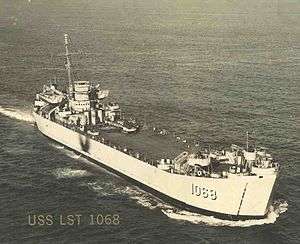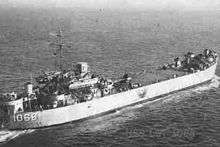USS Orange County (LST-1068)
 USS Orange County (LST-1068) off the coast of San Diego, returning from a tour of duty in Korea during the Korean War | |
| History | |
|---|---|
| Name: | USS LST-1068 |
| Builder: | Bethlehem-Hingham Shipyard, Hingham, Massachusetts |
| Laid down: | 31 January 1945 |
| Launched: | 3 March 1945 |
| Commissioned: | 27 March 1945 |
| Decommissioned: | 9 August 1946 |
| Recommissioned: | 8 September 1950 |
| Decommissioned: | 15 October 1957 |
| Renamed: | USS Orange County (LST-1068), 1 July 1955 |
| Struck: | 27 September 1957 |
| Honors and awards: | 4 battle stars (Korea) |
| Fate: | Sunk as a target ship, 18 June 1958 |
| General characteristics | |
| Class and type: | LST-542-class tank landing ship |
| Displacement: |
|
| Length: | 328 ft (100 m) |
| Beam: | 50 ft (15 m) |
| Draft: |
|
| Propulsion: | 2 × General Motors 12-567 diesel engines, two shafts, twin rudders |
| Speed: | 12 knots (22 km/h; 14 mph) |
| Boats & landing craft carried: | 2 × LCVPs |
| Troops: | Approximately 130 officers and enlisted men |
| Complement: | 8–10 officers, 89–100 enlisted men |
| Armament: |
|
USS Orange County (LST–1068) was an LST-542-class tank landing ship built for the United States Navy during World War II. Named for counties in the states of California, Florida, Indiana, New York, North Carolina, Texas, Vermont, and Virginia, she was the only U.S. Naval vessel to bear the name.
Laid down as USS LST-1068 on 31 January 1945 by the Bethlehem Steel Company of Hingham, Massachusetts; the ship was launched on 3 March 1945, sponsored by Mrs. Alice R. Wilbur; and commissioned on 27 March 1945 with Lieutenant Clinton E. Voyles in command.
Service history
World War II, 1945–1946
After shakedown in Chesapeake Bay, LST-1068 loaded pontoon causeways and LCT sections at Davisville, Rhode Island and embarked men at New York prior to getting underway, on 11 May, for the Pacific via the Panama Canal. On 27 June she departed Pearl Harbor for Guam via Eniwetok. LST-1068 cleared Apra Harbor, Guam with a group of LSTs on 11 August en route to Saipan. From Saipan she returned to Okinawa, arriving on the 28th. She was forced out to sea from her anchorage on 16 September to ride out a violent storm which lasted for three days and nights. On 22 September she loaded elements of the Fifth Air Force for transport to Yokohama, Japan.
After discharging the Air Corps personnel on the 27th, LST-1068 sailed on 1 October from Tokyo Bay for the little port of Ominato, where she was to drop off a Port Director Unit. On the 12th she was underway again bound for Manila via Yokohama. Arriving in Manila Bay on 26 October, LST-1068 remained for five days and then moved to Batangas and loaded occupation troops to return to Tokyo. She arrived in Tokyo on 14 November. On 28 November at Saipan, LST-1068 exchanged low-point crew members for high-point personnel of other LSTs and on 14 December she sailed for Pearl Harbor. From Pearl Harbor she was ordered to San Francisco for pre-deactivation overhaul and then to Bremerton, Washington for decommissioning.
LST-1068 decommissioned on 9 August 1946 and was placed in reserve at Astoria, Oregon.
Korean War, 1950–1953

Recommissioned on 8 September 1950 LST-1068 went through her second shakedown cruise and then sailed to the Far East via San Diego. Her actual departure was delayed, however, while she underwent repairs for a hole torn in her bottom by striking a submerged LCI. Repaired and loaded, she sailed in January 1951 with a scheduled stop at Pearl. In February, LST-1068 arrived in Yokosuka, and the following month she made her first entrance into Korean waters. Through May she was engaged in operations at Inchon, and in June, was on her way back to the U.S. Following overhaul, training and upkeep, which lasted for several months, she returned to the Far East in January 1952.
LST-1068 carried out a rigorous schedule which kept her busy until October, landing troops and supplies and shipping prisoners. She participated in operations at Sokchori, Koje-do, and Wonsan, with brief but frequent trips to Pusan, Cho-do, and Yokosuka, Japan. LST-1068 returned to the U.S. again in October, arriving in San Diego around Thanksgiving. The s:Korean Armistice Agreement was signed on 27 July 1953 at the time that LST-1068 was preparing for her third deployment.
Pacific, 1953–1957
She departed San Diego on 1 August with the landing craft repair ship Satyr (ARL-23) and LST-819. Arriving in Japan on 21 September, and following a three-week stay at Yokosuka, she proceeded to Kobe, and then to Sasebo. During November, she participated in a series of training exercises at Tokchok-to, Korea, an island near Inchon.
In January 1954 LST-1068 conducted training at Okinawa, and in March, at Iwo Jima, she was involved in the largest training operation she had ever experienced. On 17 June she joined with five LSTs of LST Division 13, for a return passage to San Diego. Upon arrival she was assigned primarily local operations and periods of upkeep. December 1954 and January 1955 were spent in overhaul at San Pedro, California. The ship was renamed USS Orange County (LST-1068) on 1 July 1955.
Decommissioning and sale
Orange County continued to provide a vital service to the Navy until she decommissioned on 15 October 1957. The ship was struck from the Naval Vessel Register on 27 September 1957 and subsequently sunk as a target vessel on 18 June 1958.
Awards
LST-1068 earned four battle stars for her Korean War service.
References
This article incorporates text from the public domain Dictionary of American Naval Fighting Ships.
- "Orange County". Dictionary of American Naval Fighting Ships. Retrieved 28 March 2007.
- "LST-1068 Orange County". Amphibious Photo Archive. Retrieved 28 March 2007.